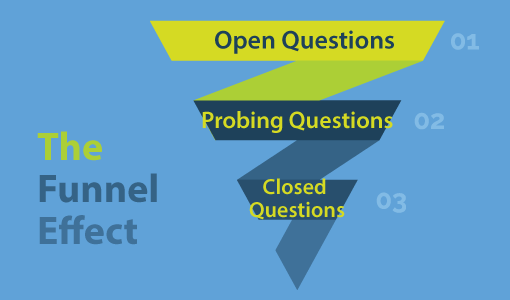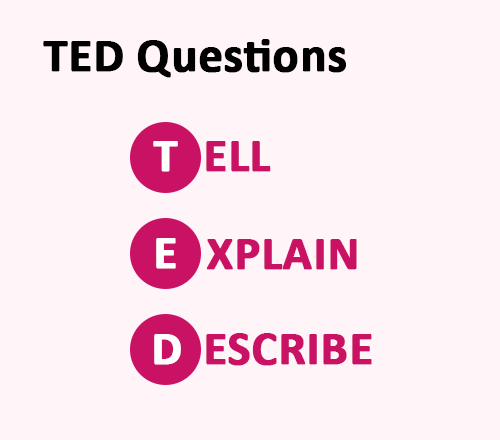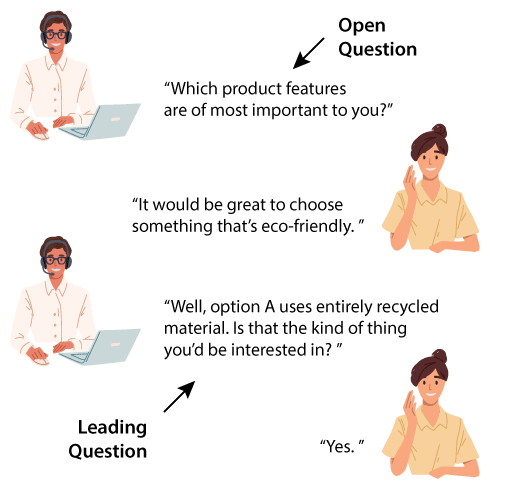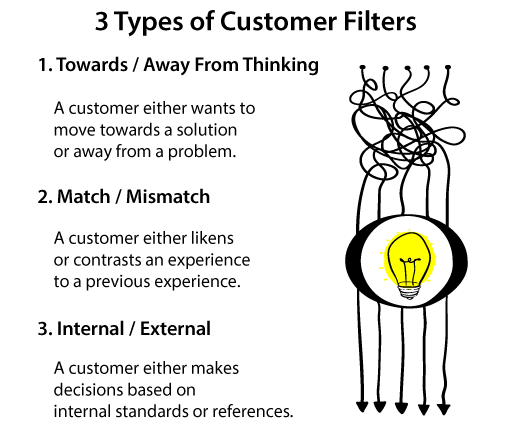9th September 2020

Effective questioning is a cornerstone of exceptional customer service, enabling advisors to uncover customer needs, resolve issues efficiently, and foster meaningful interactions.
By mastering questioning techniques, customer service professionals can enhance communication, build rapport, and ensure customer satisfaction.
We examine six key questioning strategies (open and closed questions, probing questions, funnel questions, TED questions, leading questions, and signposting) and provide practical tips to implement them effectively in customer interactions.
Asking the right questions at the right time helps customer service teams gather key information efficiently, ensuring they understand needs, resolve issues quickly, and provide a smooth experience.
It is therefore an invaluable skill for customer service teams.
Key questioning techniques for customer service include:
So lets take a look at each of these.
An open question is a question that starts with “how”, “what”, “when”, “where”, “who” or “why” and cannot be answered with a simple “yes” or “no”.
You will likely use open questions when:
For these reasons, advisors are often recommended to ask open questions as often as possible and then to follow up with a closed question when they want to confirm their understanding of something.
As you may have guessed, a closed question is the exact opposite of an open question. So these are questions to which the customer can only answer “yes” or “no”.
Below are some examples of open and closed questions which will help to reaffirm your understanding of the distinction between them.
| Open Questions | Closed Questions |
|---|---|
| How can I help you? | Can I help you? |
| How did you feel about our service today? | Did you experience good customer service today? |
| Which features of our service do you like most? | Do you like our service? |
| What are you looking for? | Are you interested in buying something? |
| What would make you consider using our service again? | Would you consider using our service again? |
One word of caution, though, before using open questions, is to be wary of stacking questions. This means asking two or more open questions at once.
For example, if you ask a customer: “Why are you unhappy with our current service? And how much money do you think you could save moving elsewhere?” The customer will generally only answer the last question, even though it might be of lesser importance.
For more on open questions, read our article: Open Questions to Use in Customer Service
A probing question is a question that you ask to gain greater insight into what someone has just told you.
Asking probing questions in customer service can help you improve the overall experience by responding to a customer’s actual needs instead of making assumptions. It can also help to improve First Contact Resolution (FCR) rates.
We have put together some sample probing questions – also known as probe questions – that can help gather more information and better understand customers’ feelings:
For examples of probing questions, read our article: 15 Example Probing Questions to Better Understand Your Customers
Funnel questions, (also known as Funnel Questioning or the Questioning Funnel), derive from something called “The Funnel Effect”.
The Funnel Effect works in three phases, as highlighted in the graphic below.

Try to start with open questions about the subject at hand, as this will give you all the information you require to take the conversation further.
These are the questions which will allow you to delve deeper into the customer’s answers to your open questions, finding out the reasons and emotions behind those answers.
Examples of these funnel questions to probe for information include:
Asking closed questions allows you to confirm both your own and the customer’s understanding of what has been discussed in that specific line of questioning.
When you string together your questions in this fashion, they are known as funnel questions. These provide a nice guideline for contact centre advisors to use.
However, Lindsey, one of our readers, warns: “Try not to use it rigidly, as the advisor may need to confirm the information they receive from an open question with an immediate closed question.”
Also, the advisor may need to open with a closed question to immediately confirm that they are speaking with the right person.
So while it’s good to use all three question types, you don’t need to stick to the principles of the Funnel Effect. Sometimes it’s better to use them intermittently.
For more information using the funnel questioning technique, read our article: How to Use Funnel Questions – With Examples

TED questions are particularly useful for open-ended discussions, allowing customer service representatives to collect valuable information while making the customer feel heard and understood.
And when using probing questions, TED can become your best friend.
The acronym TED stands for Tell, Explain, and Describe, representing three key prompts that help guide conversations and uncover deeper insights.
We have put together some examples of TED questions that can help encourage detailed responses and gather valuable insights from customers:
It can be great to use these TED questions to probe customers when the advisor feels as though they have heard something that they would like some more information on.
These probing TED questions help to pinpoint the relevant insight from a customer’s open response and can therefore work well when used between open and closed questions.
The style of wording also helps to prompt the customer into giving the advisor all the relevant information in regard to their query.
As Gordon Walker, a contact centre trainer, says: “By starting a question with one of these words, you are essentially demanding an answer from the customer without letting them know that you are.”
For some excellent examples of TED questions, read our article: 15 TED Questions for Customer Service – With Examples
A leading question is a question that suggests a particular answer and can be used well in customer service and sales to attempt to influence a response.
These questions are therefore a form of persuasion and can work particularly well when dealing with a fence-sitting customer who is struggling to make a decision.
To use leading questions effectively in these scenarios, it is best to set them up with an open question, such as: “What features are most important to you?”
When the customer responds, you can then relate the feature to an option and use a leading question to position that question in a favourable way – just like in the example below.

If you are looking for leading question examples we have put a few together for you:
From these examples, we can see that leading questions are designed to make the customer say “yes”, which can be a powerful tool in the art of persuasion.
But remember when dealing with angry customers it can be perhaps even more persuasive to do things like offer free trials, to help minimize the risk for the customer.
Signposting is a great way to set up questions to help customer conversations flow and engage customers.
This technique centres around the phrase: “In a moment.” So, you will be using statements like:
These little phrases will stop customers rummaging around their house for pens, credit cards etc., because you have already given them that little heads-up.
Not only will this save time on calls, but it will allow customers to think through what will be asked of them, so they can fully prepare and properly think through how they will respond to your questions.
To find out more about this technique, read our article: Signposting – Reduce Your Average Handling Time (AHT) by 15 Seconds
Do you want to download these examples of questioning techniques to share with your team?
Get your free download of Examples of Questioning Techniques for Customer Service now:
To improve questioning and probing, active listening is the most important skill to develop.
After all, advisors need to stay focused, refrain from interrupting and recap key bits of information that the customer gave them.
As Christine Knott, the former Managing Director at Beyond the Box, says: “There is absolutely no point in us asking questions if we are not prepared to listen.”
So if we want the techniques presented in this article to be as effective as possible, we are going to need to develop listening as a key contact centre skill.
Also, perhaps not to the same extent, for the most effective contact centre communication, we want our advisors to have the five following questioning and probing skills.
For more key customer service skills that can be great to coach in the contact centre, read our article: Super-Agents: The Top Ten Qualities of Great Contact Centre Agents
When we probe customers, we are looking to gather more insight into something that they have just told us. By using probing techniques, customer service representatives can encourage customers to elaborate, clarify their concerns, and provide the information needed to resolve issues effectively.
You may also find these techniques useful when uncovering the customer’s intended call outcome or when they don’t sound overly happy with the course of the conversation.
The simplest probing technique that you can use to elicit more information from customers is to actively validate the little pieces of information that they give you.
By using statements like those below, an advisor can show an interest in the little things that the customer is saying, to create an environment where the customer feels actively encouraged to talk more.
With the help of these phrases, we can also reassure the customer of their previous choices, if they seem anxious about their previous decision-making. We can support them by demonstrating an understanding of their thought process.
Just remember to use an upbeat, authentic tone to avoid patronizing the customer. Smiling while speaking is a good tip to help you achieve that.
For more on the topic of making customers feel good about themselves, read our article: Top 25 Positive Words, Phrases and Empathy Statements
People communicate in different ways. If we can communicate with customers in the way that best suits them, they will respond better to our probing.
Fortunately, this doesn’t have to be complicated, as customers will generally prefer one of two methods of communication.
These are:
For more on using these two methods of communication, while better controlling calls, check out the video below, which comes from Carolyn Blunt.
Knowing when to use either method of communication will enhance your probing skills and is a simple way to improve customer experience.
There are many different factors that play a part in what information we let in and what we leave out when talking to customers and probing them for more insights.
In order to best communicate with customers, we want to identify their main drivers for calling and we can do this by using “filtering” as a probing technique.
Filtering helps us to determine what type of customer we are talking to and the picture below shows three key types of customer filters.

Once the advisor recognizes the customer’s key drivers through using these filters, they can adapt how they probe customers, if coached effectively.
Let’s take this first filter as an example, “Towards / Away from Thinking”.
When a customer wants to move towards a solution, the agent should focus their probing around finding the solution.
For example, an advisor could say: “What would be the best solution for you today, Mr Smith?”
When a customer wants to move away from a problem, the agent should focus their probing around helping the customer steer clear of the situation and prevent it from happening again.
For example, an advisor could say: “Let’s looking into finding a reason for this immediately. When did the problem first arise?”
For more on how to use this probing technique in the contact centre, read our article: Want to Speak in the Same Language as the Customer? Use Filtering!
This technique is another that is all about matching the customer’s preferences in how they communicate and how much information we give them.
To use this technique, you need to understand the difference between big chunk and small chunk customers, as highlighted below.
These customers are focused on the big picture and want very few details.
With big chunk customers, just get to the point. When probing the customer, focus on only the key pieces of information that are needed to solve that query.
These customers are interested in the small details and like you to be very specific.
Small chunk customers value it when you are very thorough in your probing, so listen to them and repeat back even the minute details, to show a clear understanding.
Yet the trouble with this technique is that it may not be easy to immediately spot if the customer is big chunk or small chunk.
Considering the following questions, though, will enable you to decide for yourself:
Find out more about this probing technique by reading our article: Call Control Techniques: How to Present Options to Customers
Probing customers can be a tough task when dealing with impatient customers. Techniques such as creating probing questions unique to the customer’s situation can really improve an advisor’s ability to problem-solve, but this does take time.
For customers that seem to be in a rush, an advisor can frame the conversation differently. Telling the customer what you will do for them is the perfect place to start.
“Explain to the customer that you are going to ask them some probing questions, and tell them why you are going to ask them,” suggests Lindsey, one of our readers.
In addition to this, it can be good to let the customer know what’s in it for them to answer the questions. This helps to justify all questions in advance!
To use this technique, you can start by saying: “Okay, Mr/Mrs [NAME], I’m going to ask you some questions about X, Y and Z so I can give you the best possible solution to your question/issue/situation’.”
To close this article, we wanted to share a few ideas that our readers have suggested to us on how to improve call control in the contact centre.
These techniques, which can be used throughout a customer conversation, may prove helpful when questioning and probing customers.
The key to effective questioning is simply to listen!
By listening to your customer’s answers (the whole answer), you have time to formulate what your next question will be. This will also allow you to ensure that the line of questioning has a natural flow and doesn’t sound like a scripted checklist of things you need to ask.
The main part of this technique is to ensure you don’t jump from one subject to another. Use the Funnel Effect and move on to the next line of questioning after confirming understanding with closed questions.

It is hugely important to listen to your customer. It is equally important to let the customer answer!
If, when you ask a customer a question, they aren’t immediately forthcoming with an answer, don’t rush in to fill the gap for them. It is, after all, pointless asking a question if you are going to answer it yourself from what you believe the customer might say.
Control the silence by waiting for the customer to either answer or ask for clarification of the question if they don’t understand it.
Contributed by: Michael McGarrigle
For more on the topic of controlling silences, read our article: Seven Tips to Avoid Dead Air Time in Phone Conversations
Use positive language and be energetic and enthusiastic in your delivery, as you need to motivate someone to consider the questions you are asking.
Ideally, you want to inspire them to respond in a likewise manner and to open up the call into a conversation rather than a set of questions and answers.

Use your voice to project professional confidence as your customer needs to have confidence in you, so write down what you want to say and rehearse it so that you are prepared.
Also, remember that attention should be given to ensuring that conversations are natural and not forced, while you should listen to what your customer has to say and link the answers into the next question.
Contributed by: Christine Bryant

There are contact centres who ask advisors to only use open questions for probing. This is with the thought that open questions will draw more information from the customer, which will allow the advisor to better attach a product or service to the customer’s needs.
However, open questions should not be used in isolation. Closed questions also have their benefits.
Open questions give information; closed questions give confirmation. You need closed questions as well because closed questions give direction.
You can’t hold a conversation purely on open questions because you would never confirm the information that you’ve heard and that is crucial.
When you confirm the information, it demonstrates that you have been listening and it also keeps the conversation on track – where the advisor wants it to go and the customer needs it go.
To check that the call is going in the right direction, advisors should ask customers if they are happy and have understood everything that they have so far heard. This is called “pre-closing”.
Some examples of pre-closing questions include:
What you are looking for is clarification that will give you a yes or a no, so you know that you are going in the right direction.
It signposts that you are checking, at different stages, that you are “pre-closing” what you’ve just heard, and you are getting a commitment from the customer.
Contributed by: Christine Knott

Asking the customer if they have any other questions/anything else you can help with, at the start of a call, can aid in first contact resolution.
Asking at this point allows you to plan how your questioning will flow. For instance, it may not be possible to address the first issue raised until the second issue has been resolved.
It is a good idea to deal with each issue individually and go for the easiest or quickest issue to resolve first. This gives the customer a feeling that you are helping them and getting results. If the customer raises a new query during the call you should deal with it before closing the call.
This technique avoids having to ask the same question at the end of the call, which can increase call handling time as human nature often means if we are asked if there is anything else, we will try to find something.
Contributed by: Gordon Walker
Relevant probing helps unearth the customer’s need and reduces Average Handling Time (AHT). We need to encourage advisors to ONLY do relevant probing when they seek answers to help customers.
Some of my key tips for probing customers include:
Contributed by: Pinaz Hansotia
Most important is ensuring that any interaction with a customer occurs as being conversational, relevant and intelligently positioned.
Customers should never feel they are being asked a random question that has no relation to the discussion, and this can often happen when reading from a script.
Effective call centre advisors should be able to gain meaningful insight and information from customers by positioning their dialogue in a manner appropriate to the individual conversation.
When advisors read from a prompt, it can be hard for them to connect emotionally with callers.
An advisor that sounds interested and involved in the discussion is more likely to make the consumer feel they have got some value to gain.

The most effective way to develop advisors to a high standard is not to use a script and to get them to envisage themselves as the customers.
Then they will be in a better position to understand the process and advantages to their conversations and empathize with a consumer’s decision-making process.
Empower advisors with information and support them as valued resources and they will be confident in knowing how, and when, to ask the right questions.
Contributed by: Chris Hancock
For our guidance on how to put yourself in the customer’s shoes and show empathy, read our article: 18 Empathy Statements That Help Improve Customer-Agent Rapport
To find more articles on advisor questioning and soft skills, read our articles:
Reviewed by: Robyn Coppell